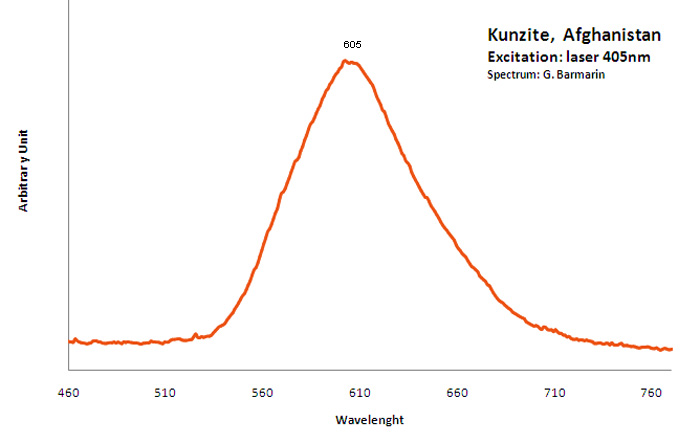Database of luminescent minerals
kunzite
Chemical formula: See SPODUMENE
Family: Silicates
Status: NON APPR
Crystal system : Monoclinic
Display mineral: OUI
Luminescence:
Longwave UV (365nm) colors: |
Orange , | ||
Shortwave UV (254nm) colors: |
Salmon pink , Violet Pink , | ||
Daylight picture

Kunzite;
Darre Pech, Nangarhar Province, Afghanistan
Photo and Copyright:
Middleearthminerals.com
Used with permission of the author
Shortwave (254nm) picture

Kunzite;
Darre Pech, Nangarhar Province, Afghanistan
UVSW, Photo and Copyright:
Middleearthminerals.com
Used with permission of the author
Do you have a photo of this mineral you would like to see in the gallery? Contact us!
Phosphorescence (in the common sense of the term) observable with the naked eye:
Type d'UV |
Couleur |
Intensité |
Fréquence d'observation |
|---|---|---|---|
UV longs (365nm): | Orange | Medium | UV courts (254 nm): | Violet red | Medium |
Thermoluminescence: OUI
Activator(s) and spectrum:
Activator(s): Mn2+ , Cr3+, TiO6,
Peaks in the spectrum (nm):
Large band at 430 nm, Mn2+ : large band peaking around 620 nm (Gorobets) large band peaking at 605nm

Col. G. Barmarin; Spectre: G. Barmarin
Comments on spectrum and activators:
The phosphorescence of Kunzite was discovered by G. F. Kunz himself in 1903. Baskerville also studyed Kunzite luminescence in 1903. Extended studies were later made on the spectra of Kunzite by Pochettino and by Nichols who found that the fluorescence emitted light was polarized. Nichols also describe the fluorescence emitted by electron excitation as two bands : a strong broad band from 515nm to 690nm and a weak one extending from 420nm to 480nm. He also pointed that the band around 600nm have a strong phosphorescence and the other band have none. Nichols studied the thermoluminescence at 325°C and found that it was not polarized. The thermoluminescence ceased at 400°C. At 20°C the peak around 590nm is nearly symetric being somewhat steeper toward the violet. On cooling to -180°C, the fluorescence color becomes much redder to the eye but the spectrum show no resolution into narrow bands (DeMent 1949) Tanaka (1921-1932) demonstrated that the most important activating agents wich cause the luminescence of Kunzite is Manganese. However, he stated that Samarium and Ytterbium had a role as activator. In the Kunzite from Pala, Ca, USA, containing a few tenths of a percent of manganese, he found in the bright orange light emitted by fluorescence 12 manganese bands, 4 samarium bands and one thallium band.
Best localities for fluorescence (*):
- Nuristan Province, Afghanistan;
- Laghman Province, Afghanistan;
- Dara-i-Pech pegmatite field, Chapa Dara District, Konar Province, Afghanistan;
- Gilgit, Gilgit District, Gilgit-Baltistan, Pakistan;
- Mt Apatite, Maine, USA (phosphorescent);
- Newry, Maine, USA (phosphorescent);
(*)The data are not exhaustive and are limited to a few remarkable localities for fluorescence
Bibliographic reference for luminescence:
- The Henkel Glossary of Fluorescent Minerals, Dr. Gerhard Henkel, Published by the FMS, 1989 ,
- Fluorescence: Gems and Minerals Under Ultraviolet Light, Manuel Robbins, 1994, Geoscience Press, ISBN 0-945005-13-X ,
- The World of Fluorescent Minerals, Stuart Schneider, Schiffer Publishing, 2006, ISBN 0-7643-2544-2 ,
- Luminescent Spectra of Minerals, Boris S. Gorobets and Alexandre A. Rogojine, Moscow, 2002 ,
- Handbook of Fluorescent Gems and Minerals, a practical guide for the gem and mineral collector, Jack de Ment, 1949 ,
Reference for luminescence on the Internet:
Images
Mineralogical reference on the Internet:
 http://www.mindat.org/show.php?name=Kunzite
http://www.mindat.org/show.php?name=Kunzite
 http://webmineral.com/data/Kunzite.shtml
http://webmineral.com/data/Kunzite.shtml
Internet Search:
 Image search on 'Google Images'
Image search on 'Google Images'
 Search for documents in all languages on Google
Search for documents in all languages on Google
A request providing no result means only that no such reference exists in the database, but it does not mean that what you are looking for does not exist, just not to our knowledge. If you think you have found an error or omission, please let us know via the contact page being sure to cite the source of information.
